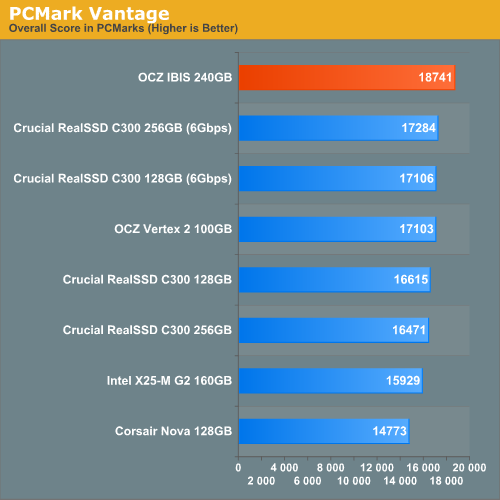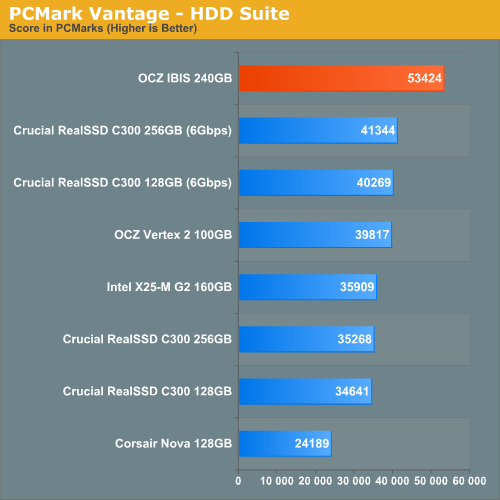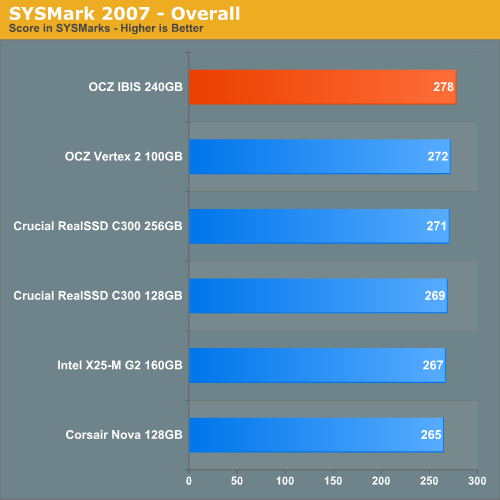OCZ's Fastest SSD, The IBIS and HSDL Interface Reviewed
by Anand Lal Shimpi on September 29, 2010 12:01 AM ESTPCMark Vantage & SYSMark 2007 Performance
With four SF-1200 controllers in RAID, the IBIS performs well as a desktop drive but honestly most desktop workloads just can’t stress it. In our PCMark Vantage test for example, overall performance went up 10% while drive performance went up 30%. Respectable gains, but not what you’d expect from RAIDing four SF-1200s together.



The fact of the matter is that most desktop workloads never see a queue depth (number of IO requests that must be fulfilled) higher than 5, with the average being in the 1 - 3 range even for heavy multitaskers. It’s part of the reason we focus on low queue depths in our desktop iometer tests. The IBIS isn’t targeted at desktop users however so we need to provide something a bit more stressful.










74 Comments
View All Comments
jwilliams4200 - Wednesday, September 29, 2010 - link
Anand:I suspect your resiliency test is flawed. Doesn't HD Tach essentially write a string of zeros to the drive? And a Sandforce drive would compress that and only write a tiny amount to flash memory. So it seems to me that you have only proved that the drives are resilient when they are presented with an unrealistic workload of highly compressible data.
I think you need to do two things to get a good idea of resiliency:
(1) Write a lot of random (incompressible) data to the drive to get it "dirty"
(2) Measure the write performance of random (incompressible) data while the SSD is "dirty"
It is also possible to combine (1) and (2) in a single test. Start with a "clean" SSD, then configure IO meter to write incompressible data continuously over the entire SSD span, say random 4KB 100% write. Measure the write speed once a minute and plot the write speed vs. time to see how the write speed degrades as the SSD gets dirty. This is a standard test done by Calypso system's industrial SSD testers. See, for example, the last graph here:
http://www.micronblogs.com/2010/08/setting-a-new-b...
Also, there is a strange problem with Sandforce-controlled "dirty" SSDs having degraded write speed which is not recovered after TRIM, but it only shows up with incompressible data. See, for example:
http://www.bit-tech.net/hardware/storage/2010/08/1...
Anand Lal Shimpi - Wednesday, September 29, 2010 - link
It boils down to write amplification. I'm working on an article now to quantify exactly how low SandForce's WA is in comparison to other controller makers using methods similar to what you've suggested. In the case of the IBIS I'm simply trying to confirm whether or not the background garbage collection works. In this case I'm writing 100% random data sequentially across the entire drive using iometer, then peppering it with 100% random data randomly across the entire drive for 20 minutes. HDTach is simply used to measure write latency across all LBAs.I haven't seen any issues with SF drives not TRIMing properly when faced with random data. I will augment our HDTach TRIM test with another iometer pass of random data to see if I can duplicate the results.
Take care,
Anand
jwilliams4200 - Wednesday, September 29, 2010 - link
What I would like to see is SSDs with a standard mini-SAS2 connector. That would give a bandwidth of 24 Gbps, and it could be connected to any SAS2 HBA or RAID card. Simple, standards-compliant, and fast. What more could you want?Well, inexpensive would be nice. I guess putting a 4x SAS2 interface in an SSD might be expensive. But at high volume, I would guess the cost could be brought down eventually.
LancerVI - Wednesday, September 29, 2010 - link
I found the article to be interesting. OCZ introducing a new interconnect that is open for all is interesting. That's what I took from it.It's cool to see what these companies are trying to do to increase performance, create new products and possibly new markets.
I think most of you missed the point of the article.
davepermen - Thursday, September 30, 2010 - link
problem is, why?there is NO use of this. there are enough interconnects existing. enough fast, they are, too. so, again, why?
oh, and open and all doesn't matter. there won't be any products besides some ocz stuff.
jwilliams4200 - Wednesday, September 29, 2010 - link
Anand:After reading your response to my comment, I re-read the section of your article with HD Tach results, and I am now more confused. There are 3 HD Tach screenshots that show average read and write speeds in the text at the bottom right of the screen. In order, the avg read and writes for the 3 screenshots are:
read 201.4
write 233.1
read 125.0
write 224.3
"Note that peak low queue-depth write speed dropped from ~233MB/s down to 120MB/s"
read 203.9
write 229.2
I also included your comment from the article about write speed dropping. But are the read and write rates from HD Tach mixed up?
Anand Lal Shimpi - Wednesday, September 29, 2010 - link
Ah good catch, that's a typo. On most drives the HDTach pass shows impact to write latency, but on SF drives the impact is actually on read speed (the writes appear to be mostly compressed/deduped) as there's much more data to track recover since what's being read was originally stored in its entirety.Take care,
Anand
jwilliams4200 - Wednesday, September 29, 2010 - link
My guess is that if you wrote incompressible data to a dirty SF drive, that the write speed would be impacted similarly to the impact you see here on the read speed.In other words, the SF drives are not nearly as resilient as the HD Tach write scans show, since, as you say, the SF controller is just compressing/deduping the data that HD Tach is writing. And HD Tach's writes do not represent a realistic workload.
I suggest you do an article revisiting the resiliency of dirty SSDs, paying particular attention to writing incompressible data.
greggm2000 - Wednesday, September 29, 2010 - link
So how will Lightpeak factor into this? Is OCZ working on a Lightpeak implementation of this? One hopes that OCZ and Intel are communicating here..jwilliams4200 - Wednesday, September 29, 2010 - link
The first lightpeak cables are only supposed to be 10 Gbps. A mini-SAS2 cable has four lanes of 6 Gbps for a total of 24 Gbps. lightpeak loses.